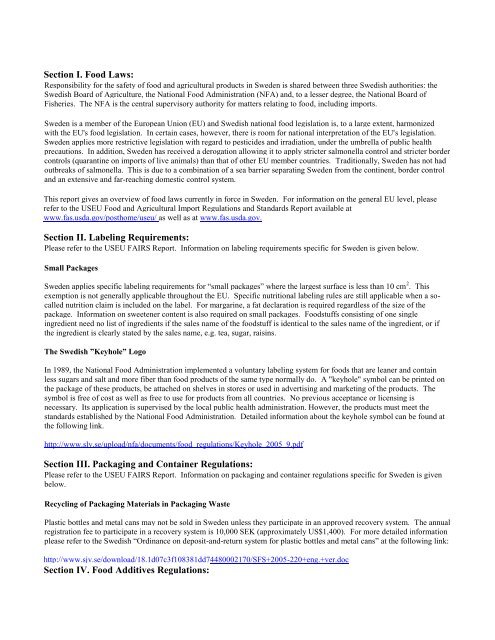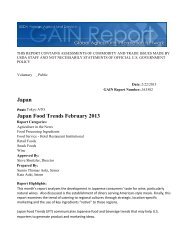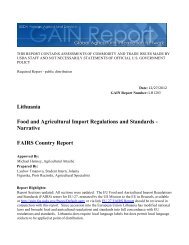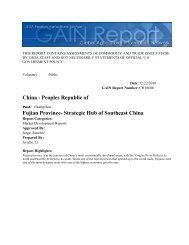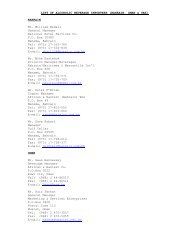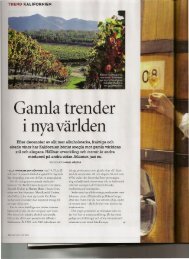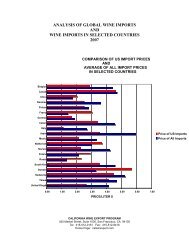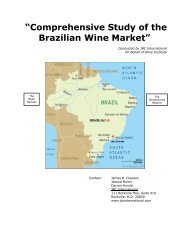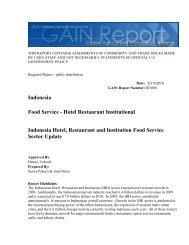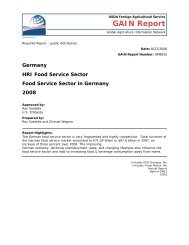FAIRS Country Report Food and Agricultural Import ... - GAIN
FAIRS Country Report Food and Agricultural Import ... - GAIN
FAIRS Country Report Food and Agricultural Import ... - GAIN
You also want an ePaper? Increase the reach of your titles
YUMPU automatically turns print PDFs into web optimized ePapers that Google loves.
Section I. <strong>Food</strong> Laws:<br />
Responsibility for the safety of food <strong>and</strong> agricultural products in Sweden is shared between three Swedish authorities: the<br />
Swedish Board of Agriculture, the National <strong>Food</strong> Administration (NFA) <strong>and</strong>, to a lesser degree, the National Board of<br />
Fisheries. The NFA is the central supervisory authority for matters relating to food, including imports.<br />
Sweden is a member of the European Union (EU) <strong>and</strong> Swedish national food legislation is, to a large extent, harmonized<br />
with the EU's food legislation. In certain cases, however, there is room for national interpretation of the EU's legislation.<br />
Sweden applies more restrictive legislation with regard to pesticides <strong>and</strong> irradiation, under the umbrella of public health<br />
precautions. In addition, Sweden has received a derogation allowing it to apply stricter salmonella control <strong>and</strong> stricter border<br />
controls (quarantine on imports of live animals) than that of other EU member countries. Traditionally, Sweden has not had<br />
outbreaks of salmonella. This is due to a combination of a sea barrier separating Sweden from the continent, border control<br />
<strong>and</strong> an extensive <strong>and</strong> far-reaching domestic control system.<br />
This report gives an overview of food laws currently in force in Sweden. For information on the general EU level, please<br />
refer to the USEU <strong>Food</strong> <strong>and</strong> <strong>Agricultural</strong> <strong>Import</strong> Regulations <strong>and</strong> St<strong>and</strong>ards <strong>Report</strong> available at<br />
www.fas.usda.gov/posthome/useu/ as well as at www.fas.usda.gov.<br />
Section II. Labeling Requirements:<br />
Please refer to the USEU <strong>FAIRS</strong> <strong>Report</strong>. Information on labeling requirements specific for Sweden is given below.<br />
Small Packages<br />
Sweden applies specific labeling requirements for “small packages” where the largest surface is less than 10 cm 2 . This<br />
exemption is not generally applicable throughout the EU. Specific nutritional labeling rules are still applicable when a socalled<br />
nutrition claim is included on the label. For margarine, a fat declaration is required regardless of the size of the<br />
package. Information on sweetener content is also required on small packages. <strong>Food</strong>stuffs consisting of one single<br />
ingredient need no list of ingredients if the sales name of the foodstuff is identical to the sales name of the ingredient, or if<br />
the ingredient is clearly stated by the sales name, e.g. tea, sugar, raisins.<br />
The Swedish ”Keyhole” Logo<br />
In 1989, the National <strong>Food</strong> Administration implemented a voluntary labeling system for foods that are leaner <strong>and</strong> contain<br />
less sugars <strong>and</strong> salt <strong>and</strong> more fiber than food products of the same type normally do. A "keyhole" symbol can be printed on<br />
the package of these products, be attached on shelves in stores or used in advertising <strong>and</strong> marketing of the products. The<br />
symbol is free of cost as well as free to use for products from all countries. No previous acceptance or licensing is<br />
necessary. Its application is supervised by the local public health administration. However, the products must meet the<br />
st<strong>and</strong>ards established by the National <strong>Food</strong> Administration. Detailed information about the keyhole symbol can be found at<br />
the following link.<br />
http://www.slv.se/upload/nfa/documents/food_regulations/Keyhole_2005_9.pdf<br />
Section III. Packaging <strong>and</strong> Container Regulations:<br />
Please refer to the USEU <strong>FAIRS</strong> <strong>Report</strong>. Information on packaging <strong>and</strong> container regulations specific for Sweden is given<br />
below.<br />
Recycling of Packaging Materials in Packaging Waste<br />
Plastic bottles <strong>and</strong> metal cans may not be sold in Sweden unless they participate in an approved recovery system. The annual<br />
registration fee to participate in a recovery system is 10,000 SEK (approximately US$1,400). For more detailed information<br />
please refer to the Swedish “Ordinance on deposit-<strong>and</strong>-return system for plastic bottles <strong>and</strong> metal cans” at the following link:<br />
http://www.sjv.se/download/18.1d07c3f108381dd74480002170/SFS+2005-220+eng.+ver.doc<br />
Section IV. <strong>Food</strong> Additives Regulations:


